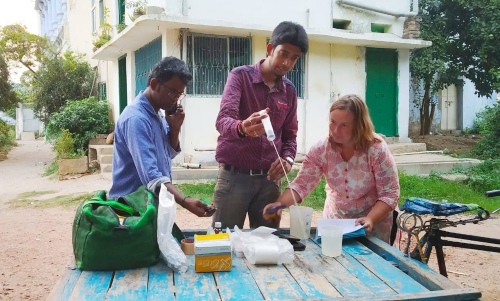
Unveiling potential hazards in Bihar's drinking water
Dr Laura Richards, a Dame Kathleen Ollerenshaw Research Fellow (Academic), tells us about her field research in Bihar to unveil potential hazards in drinking water by collecting samples of groundwater.
Groundwater quality challenges
The provision of safe drinking water supplies is crucial to public health, wellbeing and economic prosperity across the world. Understanding the distribution of dangerous natural chemical contaminants like arsenic and fluoride in groundwater, and other pollutants including pathogens and emerging organic contaminants, is important for public health and the protection of valuable groundwater resources.
With more than 500 million people reliant on groundwater in the Ganga River Basin alone, the groundwater demand is larger than that of any country outside India, and is set to increase due to population growth and economic development. However, groundwater resources in the Ganga Basin, and elsewhere, can be vulnerable to surface-derived contamination, as well as contamination from naturally occurring arsenic, both of which may be impacted by increased groundwater usage.
Field campaigns in Bihar
Our extensive field campaigns across the northern state of Bihar, India allowed us to collect hundreds of groundwater samples from private and government wells. Jointly with a Mahavir Cancer Sansthan team, we're able to study the distribution of dangerous naturally occurring contaminants, such as arsenic and uranium, in the groundwater.

In an associated higher resolution study in Patna, the capital of Bihar, we're able to evaluate the distribution of anthropogenically sourced emerging organic contaminants in groundwater in the context of a rapidly developing city impacted by rapid urbanisation and relatively limited infrastructure. The presence of emerging organic contaminants in groundwater is particularly important because of concerns regarding potential development of antimicrobial resistance in the environment.
Both of these studies have important implications on understanding current and future groundwater hazards in Bihar. These studies are likely to inform further monitoring and remediation efforts, and ultimately may underpin future benefits in the wider community, through the design and implementation of improved remediation schemes.
Indo-UK partnerships for research and impact
Along with colleague Dr David Polya, Professor of Environmental Geochemistry in the Department of Earth and Environmental Sciences, we’re working in close collaboration with Indian and UK colleagues to understand and address groundwater contamination. Through the FAR-GANGA project, we’re investigating groundwater vulnerability in the Ganga River Basin to predict future changes in groundwater arsenic and engage with key stakeholders regarding groundwater risks and remediation.
Field campaigns in Bihar have generated substantial media interest at state and national level in India. Through field campaigns, we’ve been able to interact with a wide range of people from rural villagers to NGO workers, community leaders and policymakers. Through these collaborations, we’re fostering mutual knowledge exchange and creating opportunities for impact and future research directions. These interactions also contribute to the development of next generation researchers and promote the visibility of women and other underrepresented groups in Science, Technology, Engineering, Maths and Medicine (STEMM).
The strong collaborations that have been developed through FAR-GANGA allow our staff and students to work in close partnership with Indian and UK experts, and help to bridge the gap between fundamental research and impact.
FAR-GANGA is a wider consortium supported by the DST-Newton Bhabha-NERC-EPSRC Indo-UK Water Quality Programme and is a collaboration between The University of Manchester, National Institute of Hydrology, Mahavir Cancer Sansthan, Indian Institute of Technology Kharagpur, Indian Institute of Technology Roorkee, British Geological Survey, University of Birmingham and University of Salford.

